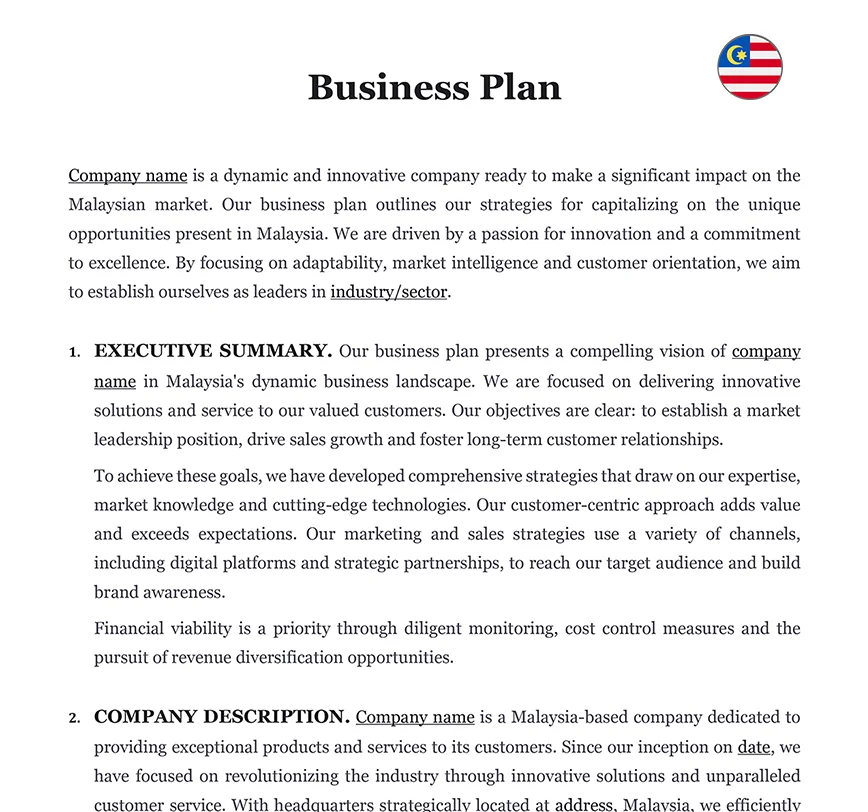Ready to use legal template
Drafted by experienced lawyers
Compliant with Malaysian law
Ready to use legal template
Drafted by lawyers
Compliant with Malaysian law
Home › Business contracts › Business Plan
Learn more about Business Plan in Malaysia
A business plan is a comprehensive document that outlines the goals, strategies, and operations of a business venture. It serves as a roadmap for entrepreneurs and organizations, providing a detailed overview of their business idea, market analysis, financial projections, and implementation strategies. A well-crafted plan not only helps entrepreneurs clarify their vision and objectives but also serves as a vital tool for securing funding, attracting investors, and guiding decision-making. Themis Partner offers you an easy to edit Business Plan drafted by Lawyers to comply with the law in Malaysia.
Table of contents
What is a Business Plan?
A business plan is a written document that outlines the goals, objectives, strategies, and financial forecasts of a business. It serves as a roadmap for entrepreneurs, guiding them in establishing and operating their business effectively. This plan typically includes sections that cover various aspects of the business, such as executive summary, company description, market analysis, product or service offerings, marketing and sales strategies, organisational structure, financial projections, and funding requirements.
Why use a Business Plan?
There are several compelling reasons why entrepreneurs should use this plan. Here are some key reasons:
1. Clear Vision and Goals
It helps entrepreneurs articulate their vision for the business and set clear goals. It allows them to define their mission, values, and objectives, providing a roadmap for the future.
2. Strategic Planning
It enables entrepreneurs to develop a strategic approach to their business. It involves analysing the market, identifying target customers, understanding competition, and formulating strategies to gain a competitive edge. This helps in making informed decisions and minimising risks.
3. Financial Planning
It includes financial projections and budgeting, which aids in assessing the financial feasibility of the business. It helps entrepreneurs determine the funding needed, forecast revenue and expenses, and understand cash flow requirements. This is vital for attracting investors and securing financing.
4. Attracting Investors and Partners
A well-crafted plan enhances the credibility of the business and attracts potential investors, partners, and lenders. It demonstrates that the entrepreneur has conducted thorough research, has a solid strategy in place, and understands the market dynamics.
5. Operational Guidance
It provides a framework for managing day-to-day operations. It outlines the organisational structure, responsibilities, and processes, ensuring that everyone in the business is aligned and working towards common goals.
6. Measuring Progress and Accountability
With it, entrepreneurs can establish key performance indicators (KPIs) and milestones to track progress. Regularly reviewing and comparing actual results against the plan allows for adjustments, accountability, and measuring success.
7. Adapting to Changes
These documents are not static documents; they can be revised and adapted as circumstances change. They provide a foundation for evaluating market shifts, industry trends, and new opportunities, enabling entrepreneurs to make strategic adjustments to stay competitive.
ℹ️ Overall, using a plan provides structure, clarity, and direction to entrepreneurs. It helps them make informed decisions, attract resources, and navigate the challenges of running a successful business.
What should a Business Plan include?
A comprehensive plan should include several key elements to provide a thorough understanding of the business and its strategies. These elements typically include an executive summary, company description, market analysis, product or service offerings, marketing and sales strategies, organisational structure, financial projections, and funding requirements.
| ➤ The executive summary provides a concise overview of the entire plan, highlighting the key points and enticing readers to continue. |
| ➤ The company description delves into the business's mission, vision, values, and legal structure. |
| ➤ The market analysis section examines the industry landscape, target market, competition, and potential opportunities. |
| ➤ It is followed by a detailed description of the product or service offerings, including their unique features and value proposition. |
| ➤ The marketing and sales strategies outline how the business plans to reach and attract customers. |
| ➤ The organizational structure clarifies the roles and responsibilities within the company. |
| ➤ Financial projections encompass revenue forecasts, expense estimates, cash flow analysis, and profitability projections. |
| ➤ Finally, the funding requirements section highlights the financial needs of the business and its plans for obtaining funding. |
ℹ️ By including these crucial elements, the document presents a comprehensive and well-rounded view of the business, enabling entrepreneurs to make informed decisions and communicate their vision effectively.
How does it contribute to the success of a business?
In Malaysia, a well-developed business plan plays a crucial role in contributing to the success of a business. It provides a roadmap for entrepreneurs, enabling them to navigate the competitive landscape and make informed decisions. Furthermore, a business plan serves as a foundation for drafting essential legal agreements, such as the Shareholders Agreement and Share Purchase Agreement. These agreements define the rights, responsibilities, and obligations of shareholders, ensuring clarity and transparency in the management and operation of the business. The shareholders agreement outlines the roles, voting rights, and profit-sharing arrangements among shareholders, fostering a harmonious and cooperative environment. On the other hand, the share purchase agreement governs the purchase and transfer of shares, protecting the interests of both buyers and sellers. By incorporating these agreements into the business plan, entrepreneurs in Malaysia can establish a solid legal framework, build trust among shareholders, and mitigate potential conflicts, thereby enhancing the overall success and stability of the business.
What are the benefits for entrepreneurs?
Entrepreneurs can reap numerous benefits by utilising a business plan, including the establishment of a Memorandum Of Understanding (MOU). A business plan provides a structured framework for entrepreneurs to outline their goals, strategies, and financial projections. It assists in clarifying their vision, identifying target markets, and understanding competition. By documenting these aspects, entrepreneurs gain a deeper understanding of their business and can effectively communicate their ideas to stakeholders. Additionally, a business plan helps entrepreneurs secure financing by demonstrating the viability and potential profitability of their venture. Furthermore, the creation of an MOU within the business plan allows entrepreneurs to formalise agreements with partners, investors, or other entities involved in the business. The MOU outlines the terms and conditions, roles and responsibilities, and mutual objectives, creating a solid foundation for collaboration and minimising misunderstandings. Ultimately, a well-crafted business plan, coupled with an MOU, empowers entrepreneurs to navigate challenges, attract resources, and increase the likelihood of success in their entrepreneurial endeavours.
What if I don’t have a Business Plan?
Not having a business plan can significantly hinder the success and growth of a business. Without it, entrepreneurs may lack a clear roadmap and strategic direction, making it challenging to make informed decisions and set achievable goals. The document serves as a crucial tool for assessing the financial feasibility of a venture, understanding the market dynamics, and identifying potential risks and challenges. Without these insights, entrepreneurs may struggle to attract investors, secure financing, or effectively allocate resources. Additionally, it helps entrepreneurs communicate their vision, mission, and value proposition to stakeholders, such as employees, partners, and customers. Without a well-articulated plan, entrepreneurs may face difficulties in conveying their ideas and building credibility.
ℹ️ Overall, while it may be tempting to overlook the creation of this document, doing so can leave entrepreneurs without a strategic foundation, potentially leading to missed opportunities and increased risks in the competitive business landscape.
How does it mitigate risks and challenges?
A well-developed plan plays a crucial role in mitigating potential risks and challenges that entrepreneurs may encounter.
| ➤ By conducting a comprehensive market analysis, entrepreneurs can identify and assess potential risks, such as market fluctuations, competitive threats, or changing consumer preferences. This enables them to develop contingency plans and strategies to navigate these challenges effectively. |
| ➤ Additionally, it incorporates financial projections and budgeting, which allows entrepreneurs to anticipate and plan for potential financial risks, such as cash flow issues or unexpected expenses. |
| ➤ Moreover, it prompts entrepreneurs to consider operational risks, such as supply chain disruptions or regulatory changes, and develop mitigation strategies accordingly. By addressing these risks proactively, entrepreneurs can minimise their impact on the business and increase the chances of long-term success. |
| ➤ Furthermore, it encourages entrepreneurs to set realistic goals and milestones, enabling them to track progress and identify potential deviations early on. This allows for timely adjustments and proactive problem-solving, mitigating risks before they escalate. |
In summary, it serves as a risk management tool by providing entrepreneurs with a structured approach to identify, assess, and mitigate potential risks and challenges in their business operations.
SPECIAL OFFER
Startup
15 Document Package
Essential documents for running your business in Malaysia
Share information
Why Themis Partner ?
Make documents forhundreds of purposes
Hundreds of documents
Instant access to our entire library of documents for Malaysia.
24/7 legal support
Free legal advice from our network of qualified lawyers.
Easily customized
Editable Word documents, unlimited revisions and copies.
Legal and Reliable
Documents written by lawyers that you can use with confidence.




